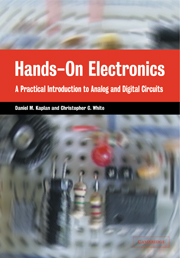Book contents
- Frontmatter
- Contents
- List of figures
- List of tables
- About the authors
- To the Reader
- Acknowledgments
- Introduction
- 1 Equipment familiarization: multimeter, breadboard, and oscilloscope
- 2 RC circuits
- 3 Diodes
- 4 Bipolar transistors
- 5 Transistors II: FETs
- 6 Transistors III: differential amplifier
- 7 Introduction to operational amplifiers
- 8 More op amp applications
- 9 Comparators and oscillators
- 10 Combinational logic
- 11 Flip-flops: saving a logic state
- 12 Monostables, counters, multiplexers, and RAM
- 13 Digital↔analog conversion
- Further reading
- Appendix A Equipment and supplies
- Appendix B Common abbreviations and circuit symbols
- Appendix C RC circuits: frequency-domain analysis
- Appendix D Pinouts
- Glossary of basic electrical and electronic terms
- Index
Introduction
Published online by Cambridge University Press: 06 July 2010
- Frontmatter
- Contents
- List of figures
- List of tables
- About the authors
- To the Reader
- Acknowledgments
- Introduction
- 1 Equipment familiarization: multimeter, breadboard, and oscilloscope
- 2 RC circuits
- 3 Diodes
- 4 Bipolar transistors
- 5 Transistors II: FETs
- 6 Transistors III: differential amplifier
- 7 Introduction to operational amplifiers
- 8 More op amp applications
- 9 Comparators and oscillators
- 10 Combinational logic
- 11 Flip-flops: saving a logic state
- 12 Monostables, counters, multiplexers, and RAM
- 13 Digital↔analog conversion
- Further reading
- Appendix A Equipment and supplies
- Appendix B Common abbreviations and circuit symbols
- Appendix C RC circuits: frequency-domain analysis
- Appendix D Pinouts
- Glossary of basic electrical and electronic terms
- Index
Summary
This book started life as the laboratory manual for the course Physics 300, ‘Instrumentation Laboratory’, offered every semester at Illinois Institute of Technology to a mix consisting mostly of physics, mechanical engineering, and aeronautical engineering majors. Each experiment can be completed in about four hours (with one or two additional hours of preparation).
This book differs from existing books of its type in that it is faster paced and goes into a bit less depth, in order to accommodate the needs of a one semester course covering the elements of both analog and digital electronics. In curricula that normally include one year of laboratory instruction in electronics, it may be suitable for the first part of a two-semester sequence, with the second part devoted to computers and computer interfacing – this scheme has the virtue of separating the text for the more rapidly changing computer material from the more stable analog and digital parts.
The book is also suitable for self-study by a person who has access to the necessary equipment and wants a hands-on introduction to the subject. We feel strongly, and experience at IIT has borne out, that to someone who will be working with electronic instrumentation, a hands-on education in the techniques of electronics is much more valuable than a black board and- lecture approach. Certainly it is a better learning process than simply reading a book and working through problems.
- Type
- Chapter
- Information
- Hands-On ElectronicsA Practical Introduction to Analog and Digital Circuits, pp. xix - xxiiPublisher: Cambridge University PressPrint publication year: 2003

